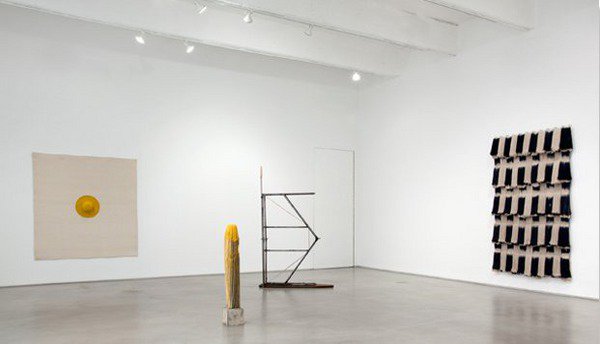Alexandre da Cunha
dal 4/10/2012 al 29/12/2012
Segnalato da
4/10/2012
Alexandre da Cunha
Le Grand Cafe' Centre d'art contemporain, Saint-Nazaire
His hybrid sculptures bring together the materials of mass consumption with an artisan's activity: the framed canvas from deckchairs mimic minimalist painting, a colony of shoehorns standing like pot plants evoke a mutant garden, the heads of toilet plungers placed atop one another play on the refinements of art deco design or on the ethnographic object, presenting themselves as if the subject for a Giorgio Morandi still life.

Co-curated by Zoe Gray and Sophie Legrandjacques
The work of Alexandre da Cunha draws upon his own dual culture, as a Brazilian artist who has lived in London for several years. At the convergence of various movements (with references to the Duchampian readymade, or to architectural modernism), his work takes everyday things and turns them into objects of wonder.
His hybrid sculptures bring together the materials of mass consumption with an artisan's activity: the framed canvas from deckchairs mimic minimalist painting ("Deck Paintings" series, 2011), a colony of shoehorns standing like pot plants evoke a mutant garden ("Field", 2010), the heads of toilet plungers placed atop one another play on the refinements of art deco design or on the ethnographic object, presenting themselves as if the subject for a Giorgio Morandi still life ("Terracotta Ebony", 2006). With a disarming poetry, Da Cunha explores the infinite plasticity of objects and produces sculptures that create images.
While preserving the integrity of his source materials, Da Cunha wittily liberates new possibilities of aesthetic, political and social signification. Beach towels become ambiguous national flags ("Velour" Series, 2006), elegant modernist tapestries turn out to be woven from mop heads, 'proletarian' objects par excellence (the "Kentucky" series).
Behind these games of displacement and the interweaving of high and popular culture is the desire to avoid overly rapid readings or ethnocentric certitudes: Da Cunha's formalist practice is marked by a strong modernist vocabulary, yet is also closely linked to the development of cultural studies in the sense that it explores the representational - and emotional - connotations aroused by objects according to their cultural context.
For his first exhibition in France, Da Cunha presents an important body of recent works, as well as a series of previously unseen sculptures: "Full catastrophe (Drums)", a group of three 'pots' that are in fact the found drums of cement mixers, onto and into which the artist has subtly intervened. Resembling antique bronzes or archaeological finds, the brutality of the original material is transformed into a collection of works marked by a great elegance. With these new works, Da Cunha adds a important element to his family of 'modest monuments' and another take on modernity.
Alexandre da Cunha was born in Rio de Janeiro in 1969. He lives and works in London. His work can currently be seen at the Sao Paolo Biennial. Among many international exhibitions, he has shown at the Camden Arts Centre (London) in 2009, at CCA Wattis Institute for Contemporary Arts (San Francisco) in 2007, and at Witte de With (Rotterdam) in the 2011 exhibition "Making is thinking". He is represented by Luisa Strina in São Paulo, Thomas Dane in London, CRG in New York and Sommer & Kohl in Berlin.
Preview on october 5th 6:30 pm
Le Grand Café
Place des Quatre z'horloges
F 44 600 Saint-Nazaire
Open everyday, exept monday and bank holidays, from 2pm/7pm.
Wednesday from 11am/7pm
Summer: open everyday except Monday, from 11am to 7pm
Free acces



